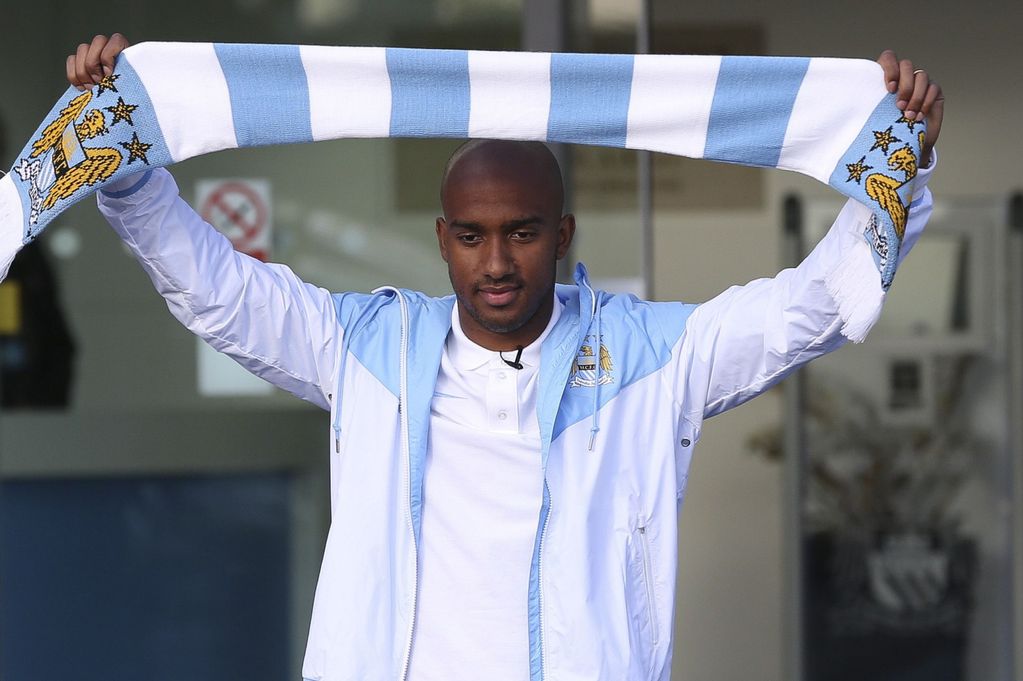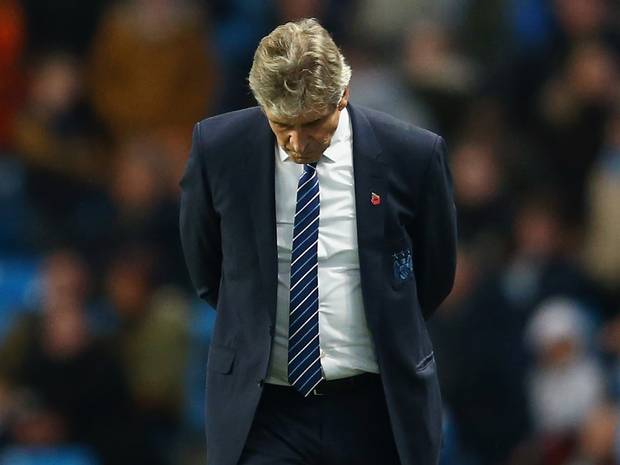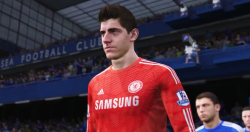
Created by Sporcle
Check out their website for more fascinating quizzes
Follow them on Twitter @sporcle
Like O-Posts on Facebook
You can also follow O-Posts on Twitter @OPosts


Kelechi Iheanacho is the future of Nigerian football. It is as simple and straightforward as that. The 18 year old attacking midfielder has shown beyond any reasonable doubt the sort of talent he is. Blessed with an eye for a pass, packs a powerful shot and full of trickery. The 2015/2016 season is expected to be his breakout season and he has the pre-‐season tour of Australia to prove himself, not just with Manchester City, but also with the Super Eagles of Nigeria.
Quick Facts:
Name: Kelechi Iheanacho
Age: 18
Position: Attacking Midfield/Centre Forward
Club: Manchester City
‘Nacho’s’ talent has never been in doubt. He was always set for great things and it is only a matter of time before he fulfils that big potential of his. A product of Nigeria’s U17 class of 2013, he was very instrumental in Nigeria winning that year’s FIFA U17 World Cup in the United Arab Emirates and it was no surprise he ended up as the tournament’s best player. He is touted to be the long term replacement for Augustine ‘Jay Jay’ Okocha in the Nigeria set-‐up but first he has to prove he can be the player everybody believes he can be.
He is presently in Australia with City and started in their 2-‐0 win over Adelaide in their first pre-‐ season game of the 2015/2016 season. Work permit and injuries delayed his introduction to the first team last season after an impressive pre-‐season in the United States, but is expected to feature in Manuel Pellegrini’s plans for the new season.
“Manchester City will not send him on loan. Plan A, B and C is for him to remain with the club next season,” a City official told the Manchester Evening News in June.
Even Pellegrini himself acknowledges how good the 18-‐year old is, and spoke of how good he can be in the future.
“A very important player for us in the future,” Pellegrini was quoted in the Manchester Evening News.
Pellegrini added: “It depends on the way he takes this profession, but I think he’s a good talent.”
Key Strengths
Iheanacho is a rare breed. Not the fastest of players, but he is blessed with a perfect close control. Besides being a traditional attacking midfielder, he can also play in a variety of positions in the attack. He has featured severally for the City youth teams as a wide attacker, a centre forward and as a second striker. Naturally a left-footer, he is quite comfortable with the ball on his right, and scores quite an awful lot of goals for a player who isn’t a natural centre forward.
Stats
He has played nine games in FIFA competitions – the U17 and U20 World Cups and has scored six goals in those games (fifa.com) -‐ an incredible average of 1.5 goals per game in those competitions!
Due to injuries, he only featured five times for the Manchester City youth teams last season, and scored three goals, including a wonderful solo effort against rivals Manchester United in the FA Youth Cup – which is an average of 1.6 goals a game – and he also made two assists.
Interested Clubs
According to transfermarkt.com, Iheanacho has a contract with Manchester City until the summer of 2016, but no clubs have really made serious efforts to get him since he joined the former English champions. He was linked with Portuguese giants, FC Porto, before opting for City and he was almost sent on loan to MLS side, Columbus Crew, but injuries meant that didn’t happen.
Quote:
“I am working hard to keep myself fit and also to break into the first team. It is not going to be easy because there are a lot of international players in the first so I just have to be patient and keep working hard,” he told Chris Oguguo for sl10.ng in June, 2014.
Written by Chris Oguguo
Follow Chris on Twitter @ChrisOguguo
Like O-Posts on Facebook
You can also follow O-Posts on Twitter @OPosts


Fabian Delph sits across the Man City club photographer, letting the ink dry on a new 5-year-deal and a nice wage hike due to his international plaudits and an all round good form. Turn the clock back to January and a similar scenario was taking place, but at a different club.
In the biggest set of U-Turns in football for as long as I can remember, Fabian Delph has signed for Manchester City for around £8 million thanks to the attraction of Champions League football and the opportunity to play with world class players.
This comes six days after releasing a statement stating his desire to lead Aston Villa into the new season as captain, a few months off signing a brand new deal with Aston Villa, and publicly announcing how he is proving loyalty still exists in football.
Now as a Villa fan, I well and truly feel betrayed by a player that the club could have easily disbanded at any point and cut our losses – with the player picking up several injuries and getting into a fight at a Birmingham nightclub, but the club stuck with him through thick and thin – realising the investment and the quality.
It seems to the outside looking in that at the first opportunity he left Villa and used us as a springboard which so many players are doing recently; Benteke is another who is expected to leave soon.
However, some may argue that signing a contract got Villa a fee that we can use to replace him with unlike if he didn’t sign a deal which would have seen him leave on a free transfer.
It’s a mixed kind of deal, but whatever the case is it has left a very bitter taste to Aston Villa losing two of their best players within one summer.
However, with around £40 million to reinvest – it is thought that Villa will make a better side with the money while replacing the players that have left.
Written by James Clark
Follow James on Twitter @JamesMRClark
Please like O-Posts on Facebook
You can follow O-Posts on Twitter @OPosts


Before the signing of Raheem Sterling for the controversial sum of £49 million, there were murmurs of Manchester City simply not having the squad able to compete for the title this year.
After all, last season was a major disappointment with a title challenge only really lasting until February and thus by March, Chelsea had the title almost in the bag.
Yet improvements haven’t been great enough yet to suggest the Sky Blues can give Chelsea or perhaps even Arsenal or Manchester United a run for their money, and here are five reasons why:
Motivation
The Manchester City squad looked unmotivated for much of last season, and that was the case in 2012-13 after they won the title the year before as well. There were many games in which one felt City simply could have done more to win the game, even away to Chelsea in January’s 1-1 draw, there was a lack of movement and drive by the likes of even David Silva and Aguero, the latter of which can be deemed more acceptable due to the number of injuries he had.
Yaya Toure was perhaps the worst offender for a perceived lack of effort, to the extent he went from effectively key player in 2013-14 to liability with flashes of brilliance in 2014-15.
Even in defeats such as to Burnley and Liverpool, City created few chances to level the game up, meaning by the end of the season, it was only fair City finished eight points behind title winners Chelsea.
Age
Make no mistake, Manchester City lacked enthusiasm and legs last season, and this is only solved in one area with the signing of Sterling. Rather around the pitch they lack youthfulness, at right-back they have Sagna and Zabaleta at ages 32 and 30 respectively; their best centre-back performer was Martin Demechelis aged 34. Yaya Toure was central to their title win in 2013-14 and is 32 and injury prone.
When at the African Cup of Nations, City failed to win a single game without him. Although Sterling injects great pace and trickery sure to give many defences difficult days, whether City can win the midfield battles around him and feed to him remains a doubt.
Consistency
Last season, Manchester City only really had one month when they were at their best and that was early December until early January, a month which saw them even go level on points with Chelsea at one point.
However, their fragility was exposed at this point, they lost to Middlesbrough, drew at home to Burnley and looked generally poor and uncertain particularly in defence. James Milner was consistently good albeit not spectacular, and the decision to let him go was not perhaps the best.
In their second seasons, the likes of Fernando and Eliaqium Mangala may well improve and find consistency, but whether star players such as Vincent Kompany and David Silva improve on last season remains to be seen.
Significant improvements in focus and quality will be needed for Manchester City to really challenge for the title this season.
Lack of depth
Much was made in 2013-14 of the impressive depth Manchester City had from defence to attack, but the inconsistent performances of Džeko, Jovetic, Sagna, Nasri and others have left City worryingly reliant on the likes of Aguero, Kompany and David Silva, the latter two underperforming last season while Aguero had fitness issues after a full World Cup.
As a result, Manchester City could not maintain their challenge last season, and unless they sign another striker, this City squad doesn’t seem to be much of an improvement on last year’s.
Quality
The reliance on Kompany, David Silva and Yaya Toure would be more acceptable were it not for the weaknesses of these three and them being somewhat found out over recent seasons. Silva has been great at times but doesn’t score enough, Toure is magnificent going forward but is easy to overrun in midfield, while Vincent Kompany has lacked the assurance and organisation he used to play with.
These defects have not been covered up as other players have not stepped up to the plate, Nasri hasn’t for Silva, Mangala and Demechelis haven’t for Kompany and Fernando, and Fernandinho hasn’t for Toure.
Sterling may well be able to for Silva and does have the potential to be Manchester City’s first world class addition since Aguero in 2011, but whether this can compensate for a shaky midfield and defence looks unlikely from afar.
Conclusion
Manchester City looked lethargic last year, yet a wholesale clear-out never came to fruition. They do not seem to be the same team as the one who would aggressively dominate teams as they did for much of 2011-14, and that can only come back with a mentality change.
Sterling could well inspire that, as he can cut inside and create problems all around the final third, but he is only 20 and cannot be expected to be wholly consistent nor carry Manchester City alongside Aguero.
For the Sky Blues to really challenge, they need improved performances across the squad from Kompany to Džeko, and that looks unlikely given many such players’ ages and lack of consistency lately, especially last season for both club and country in many cases including Kompany’s.
For the sake of the title race, let’s hope they can find the form many of them showed in both 2011-12 and 2013-14.
Written by Joshua Sodergren
Follow Joshua on Twitter @JoshSalad365
Like O-Posts on Facebook
You can also follow O-Posts on Twitter @OPosts


FYI: 1 is Lowest, 10 is the highest
Defenders in FIFA 16 or any other video game simulation are very vital to your team’s overall performance in the game.
We have listed a bunch of top defenders in FIFA 16 so that you can improve your team and therefore your performance.
1. John Terry
Overall Rating: 83
Best attribute: 84 in Defending
The veteran captain has had very consistent overall ratings in FIFA games. For three years in a row, his rating has been 83.
He is one of the best defenders in England and is very famous among English gamers.
2. Nicolás Otamendi
Overall Rating: 83
Best attribute: 87 in Defending
Otamendi was one of the most consistent defenders in La Liga this season. Because of his form, Manchester United and a few other English sides are keeping a close eye on him.
A move to the Premier League would make this brilliant defender very popular in FUT 16.
3. Mehdi Benatia
Overall Rating: 85
Best attribute: 89 in Defending
The Morocco international was brilliant for Bayern Munich this season making some crucial defending in the back.
The boost in his FIFA stats is going to make him popular this year.
4. Vincent Komapny
Overall Rating: 85
Best attribute: 87 in Defending and Physical
Kompany has insane defending and physical stats in FIFA 16 making him one of the powerful player to have in your team.
He is also good with headers, which is why most FUT players would want him in their team as he can prove to be a threat in set-piece situations.
5. Jerome Boateng
Overall Rating: 85
Best attribute: 86 rating in Defending
Boateng was one of the most successful defenders in the 2014-15 season. He made some game changing tackles and stops to make a name for himself.
He is going to be famous in the latest version of FIFA as his stats have significantly improved.
6. Diego Godin
Overall Rating: 85
Best attribute: 88 in Defending
Degio Godin had a really successful season with Atlético Madrid which has resulted in a boost in his ratings in FIFA 16. He previously had a rating of 83.
7. Gerard Pique
Overall Rating: 86
Best attribute: 88 rating in Defending
Pique’s rating in FIFA 16 has declined from FIFA 15, despite an excellent season for Barcelona this year.
With a potential of 88, he is going to be popular among Spanish players.
8. Mat Hummels
Overall Rating: 86
Best attribute: 87 rating in Defending
World Cup winner for Germany, Hummels did not quite have a great season with his club. He conceded a lot of goals and made some silly mistakes.
But despite that, he has an 86 rating in FIFA 16.
9. Sergio Ramos
Overall Rating: 87
Best attribute: 88 rating in Defending
The Spanish centre back is one of the best defender in La Liga. He had such a good record last year that Manchester United want to sign him.
Ramos is already famous among FIFA gamers, but a move to Manchester United could make him even more popular.
10. Thiago Silva
Overall Rating: 88
Best attribute: 90 rating in Defending
Thiago Silva is the best defender in FIFA 16. The PSG defender did not have the best season last term, but he still has all the required attributes to make him the best.
He was the most traded player in FIFA 15 FUT and it would not be a surprise if he is once again.
Written by Charchit Dahal
Follow Charchit on Twitter @CharchitDahal
Like O-Posts on Facebook
You can also follow O-Posts on Twitter @OPosts

The FIFA season has started and this is the time for you to boost your team. It doesn’t matter if you are playing career mode or FUT 16, your team needs a good goalkeeper.
We have made it easy for you as we have here a list of the top 10 goalkeepers in FIFA 16.
1. Manuel Neuer
Overall Rating: 90
Best attribute: 92 rating in Kicking
The World Cup winner and Ballon d’Or nominee is definitely the best keeper in FIFA 16. Neuer has pulled up some insane saves this year which has resulted in his rating boost to 90 from 88.
2. David De Gea
Overall Rating: 86
Best attribute: 89 rating in Reflexes
De Gea has been Manchester United’s best player this season, so no wonder Real Madrid desperately want him. We have seen his rating boost from 83 to 86 as he holds insane stats for reflexes and kicking.
3. Thibaut Courtois
Overall Rating: 86
Best attribute: 90 rating in Reflexes
The Chelsea custodian is definitely one of the best in England. Courtois can develop into the world’s best if he continues to perform this well again next season. He is probably going to be the most bought player in the FUT 16.
4. Claudio Bravo
Overall Rating: 85
Best attribute: 88 in Reflexes
Bravo won the treble with Barcelona and Copa America with Chile making him the most successful goalkeeper this year. All this success has helped his FIFA 16 stats as he is boosted to 85 from 81.
5. Gianluigi Buffon
Overall Rating: 85
Best attribute: 88 rating in Diving
The Juventus legend is certainly ageing, but that does not stop him from being at his absolute best. He is definitely going to be popular among Italian FIFA players.
6. Hugo Lloris
Overall Rating: 84
Best attribute: 87 rating in Positioning
Hugo Lloris is one of the most consistent goalkeepers playing in the Premier League. The French goalstopper has the same rating he had in the previous version of the game.
7. Joe Hart
Overall Rating: 84
Best attribute: 84 rating in Kicking
Manchester City and England goalkeeper Joe Hart had a pretty successful season despite his team’s underwhelming performances. He made some game changing saves, which helped secure a Champions League spot for his club. He is already popular among English gamers.
8. Petr Cech
Overall Rating: 84
Best attribute: 83 in Reflexes and Handling
The former Chelsea man still has a lot of top class goalkeeping left in him. And, this is the reason why Arsenal signed Cech. He is going to be famous with fans of both London clubs in FIFA 16 (more likely among Arsenal supporters) as he remains one of the best goalkeepers in England.
9. Diego Lopez
Overall Rating: 83
Best attribute: 88 rating in Handling
The AC Milan goalkeeper has been very profound for his club this season. He has been able to save plenty, including in one on one situations, which is why his stats in FIFA 16 have been boosted.
10. Roman Weidenfeller
Overall Rating: 83
Best attribute: 85 rating in Positioning
Weidenfeller has been one of the most consistent goalkeepers for Dortmund. With game saving reflexes, which was vital for his club in the latter phase of the season, the Germany international definitely makes it into our top 10 list.
Written by Charchit Dahal
Follow Charchit on Twitter @CharchitDahal
Like O-Posts on Facebook
You can also follow O-Posts on Twitter @OPosts

At 14, Tobias Svendsen had to get permission by the Norwegian FA to appear in a third tier game for Molde’s reserve team. Just a year later, he got his debut for the reigning champions in the cup.
The now 15-year-old midfielder is living in the shadow of his 17-year-old brother Sander Svendsen who has established himself in the first team, but Tobias is following not far behind.
QUICK FACTS:
Name: Tobias Svendsen
Date of birth: 31.08.2024 – Age: 15
Position: Midfielder
Club: Molde FK
Key strengths
His low centre of gravity, exquisite first touch, great understanding of the game and quick feet perfectly fits the bill for a modern central midfielder. He is very capable in small spaces, extremely difficult to get the ball off and is considered to be an aggressive midfielder with decent tackling abilities in defensive positions.
Molde manager Tor Ole Skullerud has on multiple occasions praised Tobias but he is keen to point out that they will not rush his development, especially as he is so young and has more physical growth to do.
“He has all the attributes to become a first team regular here at Molde. He is far ahead of his age in every way. It is still impossible to predict how far he will reach. Tobias has great potential but first he must get peace and quiet to develop,” Skullerud said to Norwegian press.
Stats
After Svendsen appeared in the 4-2 win against Rosenborg 2 at the third tier of Norwegian football over a year ago, he got a few appearances during the first team’s pre-season last winter. Then back in April 2015 he was handed his debut for the first team in the first round of the cup, a match Molde in the end won 2-0.
Considered an exceptional talent Svendsen was scouted at the age of 11 by Ajax. In fact, it was the younger of the Svendsen brothers that got the pair on the Dutch club’s radar when he was just 11, which two years later lead to his first of many trips to Amsterdam to train with the club.
For the time being Tobias is only thinking about becoming a better footballer, despite interest from Ajax. Claiming he is ‘too young’ to go professional abroad, Tobias told Norwegian press that it would be difficult to turn down an offer from Ajax ‘in a couple of years’.
“I have been abroad and seen how professional everything is, so yes, it is really tempting. I am too young to do that now, but of course it is a dream. If I receive an offer when I am 17 I would probably accept,” he said.
Written by Lars H. Thomesen
Follow Lars on Twitter @LarsHT
Like O-Posts on Facebook
You can also follow O-Posts on Twitter @OPosts

Pione Sisto’s performances during the Under-21 Euros in June have opened for a move to Ajax, according to Danish press. The 20-year-old’s talent is undeniable, and a move to a bigger club such as Ajax this summer seems likely.
In fact, Midtjylland FC, his club in Denmark, expects him to be their biggest ever sale. Considering that Midtjylland over the years have developed players such as Simon Kjær and Winston Reid and sold them to bigger European clubs, there is no doubt Sisto’s talent is incredible.
QUICK FACTS:
Name: Pione Sisto
Date of birth: 04.02.2024 – Age: 20
Position: Attacking Midfielder
Club: Midtjylland FC
Key strengths
Sisto is considered an incredible talent, much due to his exquisite pace and unpredictable dribbling. In the Danish Superliga he takes on opposing defenders with ease whether it is one, two or three defenders coming at him.
Key to any young player’s development is not being afraid of failure, and Sisto has that ability in abundance. He loves to try new skills and tricks, and more often than not he is successful.
He also has a fierce shot on him and can score from distance as well as good vision and passing abilities to set up his teammates for goal scoring opportunities.
Stats
At the age of 17, Sisto got his first team debut for Midtjylland. During his first season, 2012/13, he appeared in a fair amount of games before becoming a first team regular the following season. In 2014/15 he helped Midtjylland to their first ever league title in Denmark.
His end product is also good, notching up 17 goals in 65 matches from his midfield position for his club. His performances did not go unnoticed and he was called up for Denmark’s Under-21s in December 2014.
He made three appearances in the Under-21 Euros in June, scoring the winning goal in a 2-1 win over Czech Republic.
Interested clubs
As mentioned, Ajax are closely monitoring the 20-year-old and seem to be the club most likely to sign him this summer. Ajax have previously nurtured the talent of another Danish attacking midfielder, Christian Eriksen, who Sisto have been likened to by Denmark national coach Morten Olsen.
The transfer fee for the rapid midfielder is expected to be around €5 million, making him Midtjylland’s most expensive sale ever.
Sisto has also been linked with a move to major sides in the continent such as Arsenal, Manchester City, Barcelona and Juventus.
Written by Lars H. Thomesen
Follow Lars on Twitter @LarsHT
Like O-Posts on Facebook
You can also follow O-Posts on Twitter @OPosts